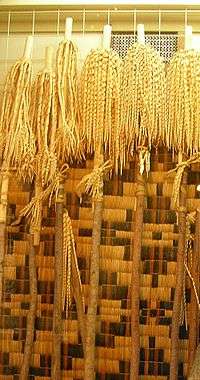Inau
Inau or Inaw (Ainu: イナウ or イナゥ) is an Ainu term for a ritual wood-shaving stick used in Ainu prayers to the spiritual world. They were used in most Ainu religious rituals, and were also frequently made to request assistance for hunting and childbirth. Some can be used multiple times, while others are destroyed immediately after one use. Their size and the direction in which they are shaved depends on which kamuy it is offered to and what is being requested.
Etymology
The word inau appears to be a loanword from other languages in the region, probably the Orok language of Sakhalin (cf. Orok illau < *ilawun); it is most likely ultimately related to Manchu ila-/ᡳᠯᠠᠮᠪᡳ(ila-mbi) "to blossom" and ilha/ᡳᠯᡥᠠ "flower."[1] The Nivkh word inau ~ nau is most likely a loanword from the same Manchu-Tungus source via Ainu; both Tungusic languages and Nivkh have an /l/ sound, whereas the Ainu language lacks an /l/ sound, so the replacement of /l/ with /n/ is probably an artefact of Ainu phonology.[2]
Description

To make inau, the bark of a branch is first peeled and then a knife called an "inawke-makiri", is repeatedly used to shave the wood into thin curled strips that form a tuft.[3] Inau are usually anywhere from five inches to a foot in length. There are several different types of inau, all with different variations in length and thickness depending on purpose. Certain types of wood were also used depending on the inau's purpose. Willow was exclusively used for offerings to good kamuy, and is preferred for this purpose, although a few other woods could be used if necessary. These inau tend to be close to a foot long. Conversely, inau made to repel illnesses and evil spirits (called wen inau) were typically made from alder, and are usually around eight inches long. Some inau also have wings attached to them, although it is unclear exactly what function they served. The number of wings varies by region; Ainu from southern Hokkaido typically made them with nine wings, while further north they were made with six or seven.[4] Inau also have shavings attached to them. Most point upwards, although chiahorokakepe or chehorokakep (Ainu チアホロカケペ or チェホロカケㇷ゚, literally "the thing shaven backward") have them pointed downward, making them very distinct from other inau. In addition, certain kinds of inau, such as Chikube-ni inau, are equipped with spears.[5]
Uses
With the exception of funerals, for which they were never made, inau were an important part of rituals involving kamuy. Because only men were permitted to participate in religious rituals, only men could make inau. Before building a house, four inau and one chiahorokakepe were placed where the hearth was to be built. Every Ainu house had inau on the hearth in honor of Kamuy Fuchi (known in Sakhalin Ainu as Unci Kamuy), and during Ainu house-warming ceremonies, three to four additional chiahorokakepe were typically placed on the hearth.[4][6] Inau were also made to requests assistance from progressively more powerful kamuy during exorcism rituals and difficult childbirth.
In addition to personal use, inau were also used in larger ceremonies. Ainu bear ceremonies featured a large number of inau, of all different kinds. Certain elders, known as ekashi, would also use inau in ceremonies to control the weather. Finally, inau were used by hunters both before and during a hunt to bring good luck.[4]
Inau made for curing diseases were dismantled immediately after their purpose was served. Keeping them for any longer than was absolutely necessary was considered extremely dangerous, and it was thought they could cause a great deal of harm to the person who made them. Conversely, inau made to more benevolent kamuy were not so quickly destroyed.[4]
See also
- Chichilaki
- Gohei, wooden wands used in Shinto rituals
References
- 池上 二良 (1980-03-31). "CiNii Article - Remarks on the Origin of the Ainu Word inaw : with Reference to the Etymology of the Uilta Word illau". Ci.nii.ac.jp. Retrieved 2011-03-12.
- TSUMAGARI Toshirō, 「サハリンの言語世界 : 単語借用から見る」 saharin no gengo sekai: tango shakuyō kara miru ("The Linguistic World of Sakhalin: A View from Loanwords"), Hokkaido University Collection of Scholarly and Academic Papers (2009).
- "Sapporo Ainu Culture Promotion Center (Sapporo Pirka Kotan)". City.sapporo.jp. 2011-02-23. Retrieved 2011-03-12.
- Munro, Neil Gordon. Ainu Creed and Cult. Columbia University Press.
- "Inau". The Field Museum. Archived from the original on September 27, 2011. Retrieved July 18, 2011.
- "Iku-Nishi of the Saghalein Ainu". Journal of the Royal Anthropological Institute. Royal Anthropological Institute. 2: 107–117. 1949. JSTOR 331115.